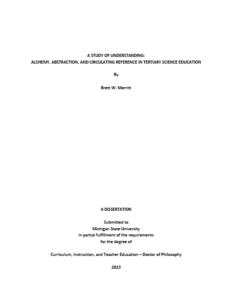Dissertation

A Study of Understanding: Alchemy, Abstraction, and Circulating Reference in Tertiary Science Education
Abstract
Understanding is widely touted to be of paramount importance for education. This is especially true in science education research and development where understanding is heralded as one of the cornerstones of reform. Teachers are expected to ‘teach for’ understanding and students are expected to ‘learn with’ understanding. This dissertation is an empirical study of the concept of understanding. After analyzing various constructions of understanding in current U.S. education literature, I suggest that understanding is defined by five distinct features—they are knowledge (or knowledge base), coherence, transfer, extrapolation, and cognition—and that these features are heavily informed and shaped by the psychological sciences. This relationship is neither good nor bad, I argue, but it means that teaching for and learning with understanding are not heavily informed and shaped by, for example, the natural sciences. Drawing from historical, philosophical, and anthropological perspectives of science, but especially from the work of Bruno Latour, I enact a radical revision(ing) of psychological notions such as “abstraction” and “transfer.” The two main purposes of this re-visioning are (1) to draw critical attention to particular characteristics of a cognitive learning theory that emphasizes abstract concepts, and (2) to align many of the principles and tools used in science education more closely with those used in empirical scientific research. Finally, by bringing some examples of teaching and learning from an undergraduate biology classroom into conversation with both psychological and empirical practices and perspectives, I suggest that problematizing the current construction of understanding creates much needed room in mainstream science education for more empirical forms of learning and styles of teaching. A shift to such forms and styles, I conclude, should prove to be more inclusive and less constraining for both students and teachers.